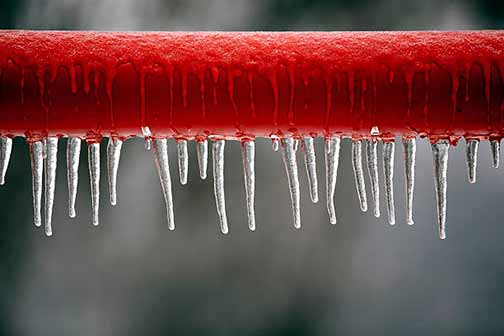
Frozen water pipes are a leading cause of water damage in homes during the cold months of winter and early spring, says Atlas Management. If your home is in a region where it gets cold in winter, exposed water pipes inside or around your home could freeze.
This problem often happens without a homeowner’s knowledge, with devastating consequences to their building and plumbing. Depending on where it happens, a frozen water pipe can affect your home in the following ways:
- Interrupt the flow of fresh water to your plumbing fixtures and appliances. This is the best-case scenario.
- Exerting pressure on the water pipe to weaken it and subsequently make that section of plumbing vulnerable to leaks.
- Crack or rupture the water pipe, leading to expensive water damage inside your home after the pipe has thawed.
Why do water pipes freeze?
Water pipes freeze when they are exposed or poorly insulated. Underground water pipes not buried below the frost line can freeze when the temperature falls to 32 °F. Depending on the weather in your area, the frost line can be as deep as 8 feet (2.4 m).
Water pipes also freeze if they are exposed. Pipes in a water meter pit or the exterior walls of the home are highly vulnerable to freezing. This is true for uninsulated concrete walls, or stud walls with no insulation between their warm inside and the water pipe.
Water pipes in unheated parts of the home may also freeze. A common area of the house, where this happens is the crawlspace. Water pipes in heated areas of the home can also freeze if warm air is not being circulated to their location.
How to prevent frozen pipes in your home
Insulate pipes
The most effective way to insulate water pipes is with foam pipe insulation. Pipes in exterior walls should have insulation between them and the cold wall. Underground pipes that are above the frost line should be insulated with layers of Styrofoam panels and pipes that run above ground should have thermal insulation. Pipes that run on the floor above a crawlspace should also be insulated.
Drain outdoor faucets and hoses
Install “freeze-proof” outside hose faucets. Unlike standard faucets with their shut-off located at the faucet, these have shut-off valves that are located inside the house. But for them to work, you must ensure that your garden hose does not have water inside it. Drain outside hoses and disconnect them. Open all external faucets to drain them.
Keep faucets slightly-open
Water pipes are more likely to freeze if the water inside is not moving. Keep the faucets in the home slightly open – let water flow at a trickle – to prevent freezing. If you will be away from your home for an extended period, shut off the water supply and open all faucets to drain the pipes inside your home.
Leave cabinet doors open
Pipes hidden behind the doors of under-sink cabinets are a common site for freezing because the closed door of the cabinet does not allow warm air to circulate to the pipes. Keeping cabinet doors slightly open will let the heat from the rest of the house circulate into the spaces underneath the sinks.
Install heat tapes
Wrapping exposed pipes with heat tapes will keep them from freezing. Some heat tapes come with a thermostat to regulate the ambient temperature and switch the heat on and off without direct human involvement. When working with heat tapes, be careful that you don’t end up damaging your pipes.
Install a hot water recirculation system
These work as long as your water heater is producing hot water and the electricity supply to your home is on. Hot water recirculation systems use a thermostatic valve to detect when the water inside the pipes is getting too cold. Warm water is then pushed into the cold water pipes to ensure the water temperature is always below the freezing point.
Reroute or replace pipes
Ultimately, the best solution might be to reroute or replace some pipes. Because they are liable to burst when they freeze, copper pipes should be replaced with PEX pipes. PEX pipes will not burst; they expand when the water inside freezes. Pipes can also be rerouted to move through heated areas of the home.
Lastly, what should you do if you find a frozen water pipe in your home?
The first option is to wait until the pipes thaw. The problem with this option is your home or some fixtures will be without water as long as the pipe stays frozen. The second problem is a frozen pipe can easily crack and leak afterwards.
The second option is to find a way to thaw the pipes. There are different ways to do this. But never try to thaw a frozen pipe by applying heat directly. If a pipe in your home is frozen, it is best to get a professional plumber to thaw the pipes safely.

